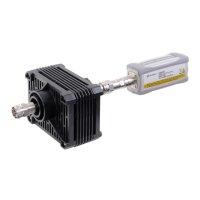3 Specifications and Characteristics
46 U2000 Series Operating and Service Guide
Switching Point
The U2000/1/2/4A power sensors have two paths, a low power path covering
- 60 dBm to - 10 dBm and a high power path covering –10
dBm to +20 dBm. The
power sensor automatically selects the proper power level path. To avoid
unnecessary switching when the power level is close to the –10
dBm point,
Switching Point Hysteresis is added. This hysteresis causes the low power
path to remain selected until approximately –9
dBm has been reached. As the
power level increases above –9
dBm, the high power path will be selected. The
high power path remains selected until approximately –11
dBm has been
reached. As the power level decreases below –11
dBm, the low power path will
be selected.
As for the U2000/1/2H and U2000/1B power sensors, to avoid unnecessary
switching when the power level is near the switch point, Switching Point
Hysteresis has been added. This hysteresis causes the low power path to
remain selected until approximately 1 dB above the switch point as the power
level is increased. Above this power, the high power path is selected. The high
power path remains selected until approximately 1 dB below the switch point
as the signal level decreases. Below this power, the lower path is selected. 20
dBm is the switch point for the U2000/1/2H sensors while the U2000/1B
sensors switch at 0 dBm.
Error
Offset at Switch Point ≤±0.5% (≤±0.02 dB) typical
Switching Point Hysteresis 1 dB typical

